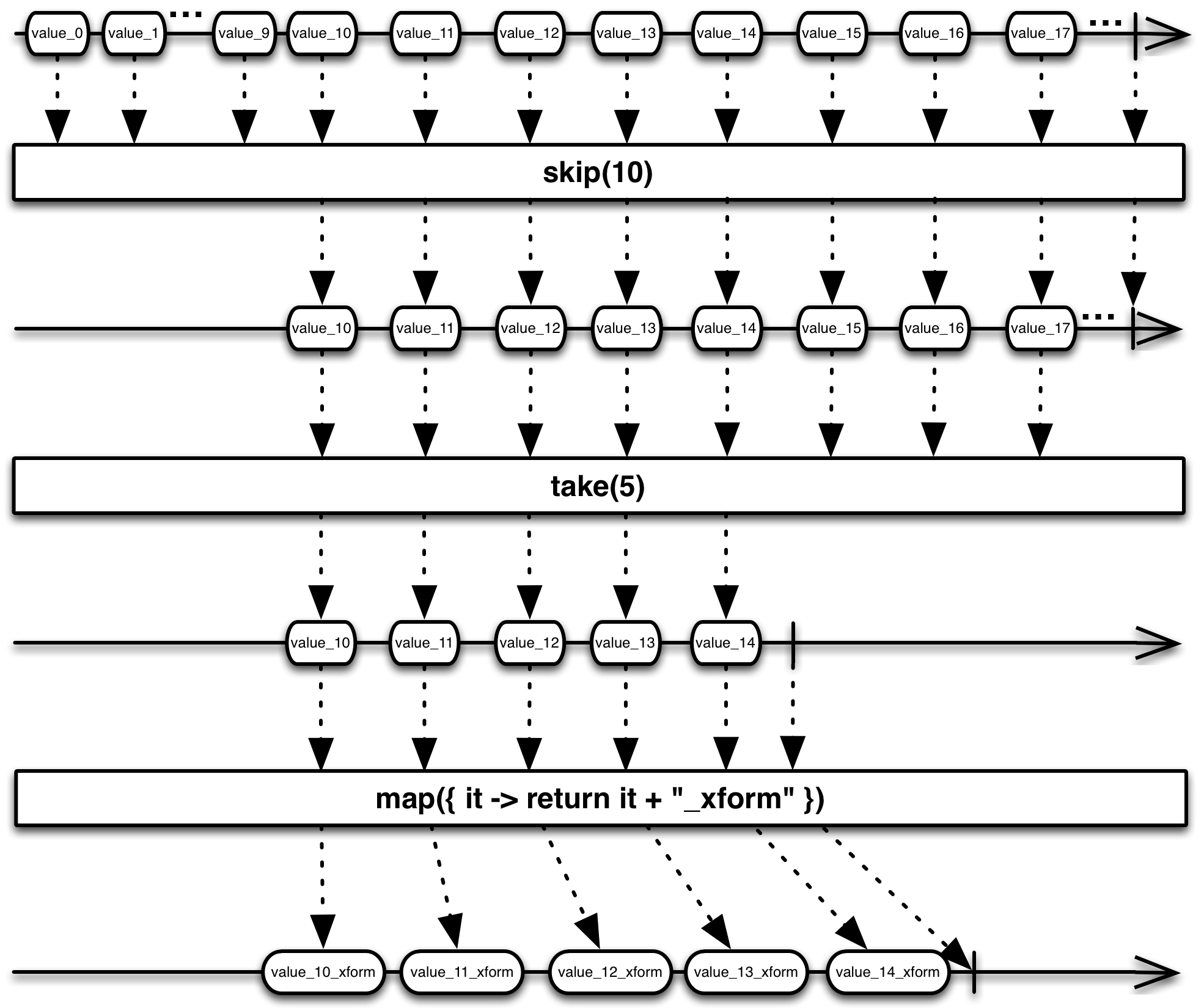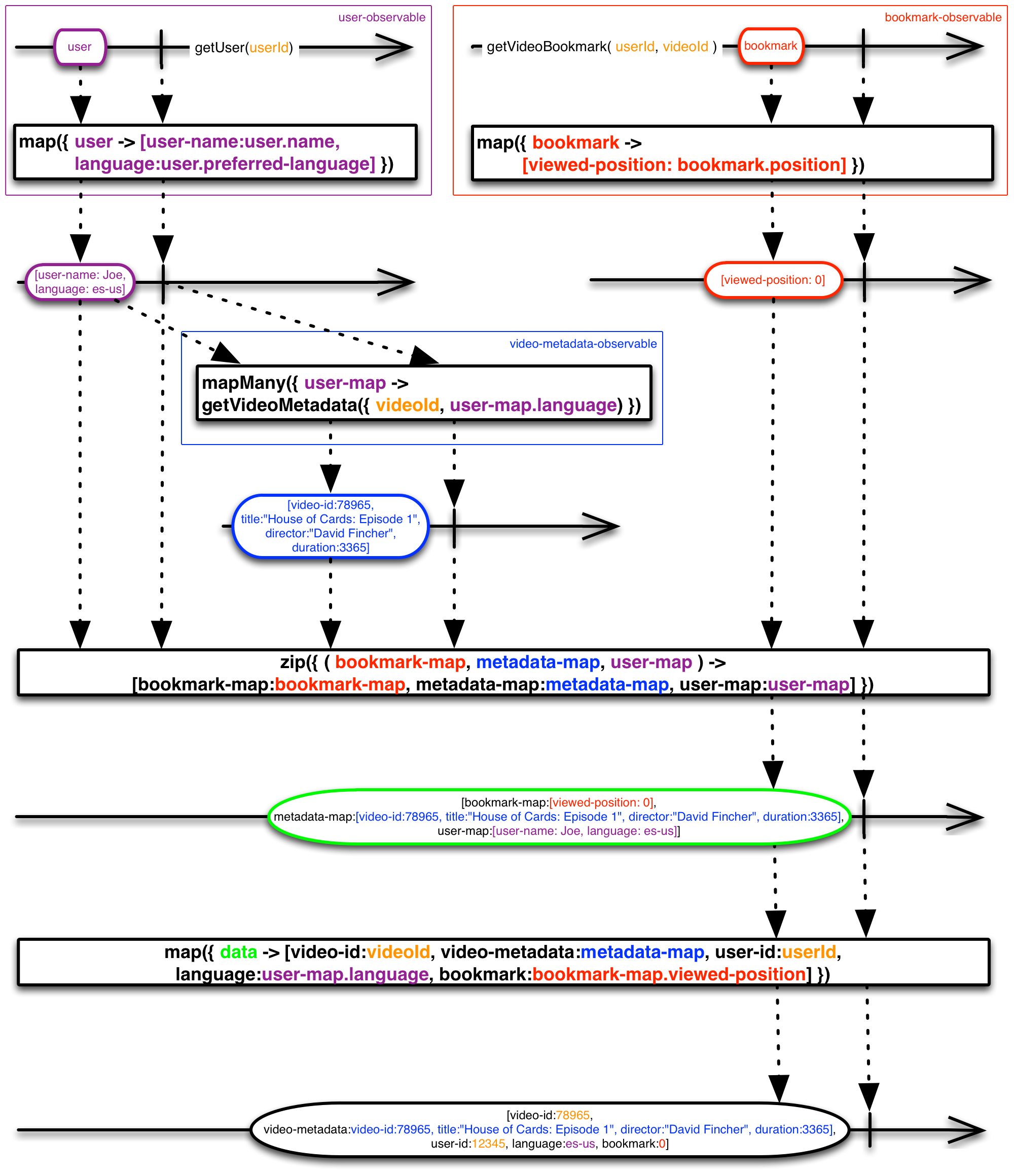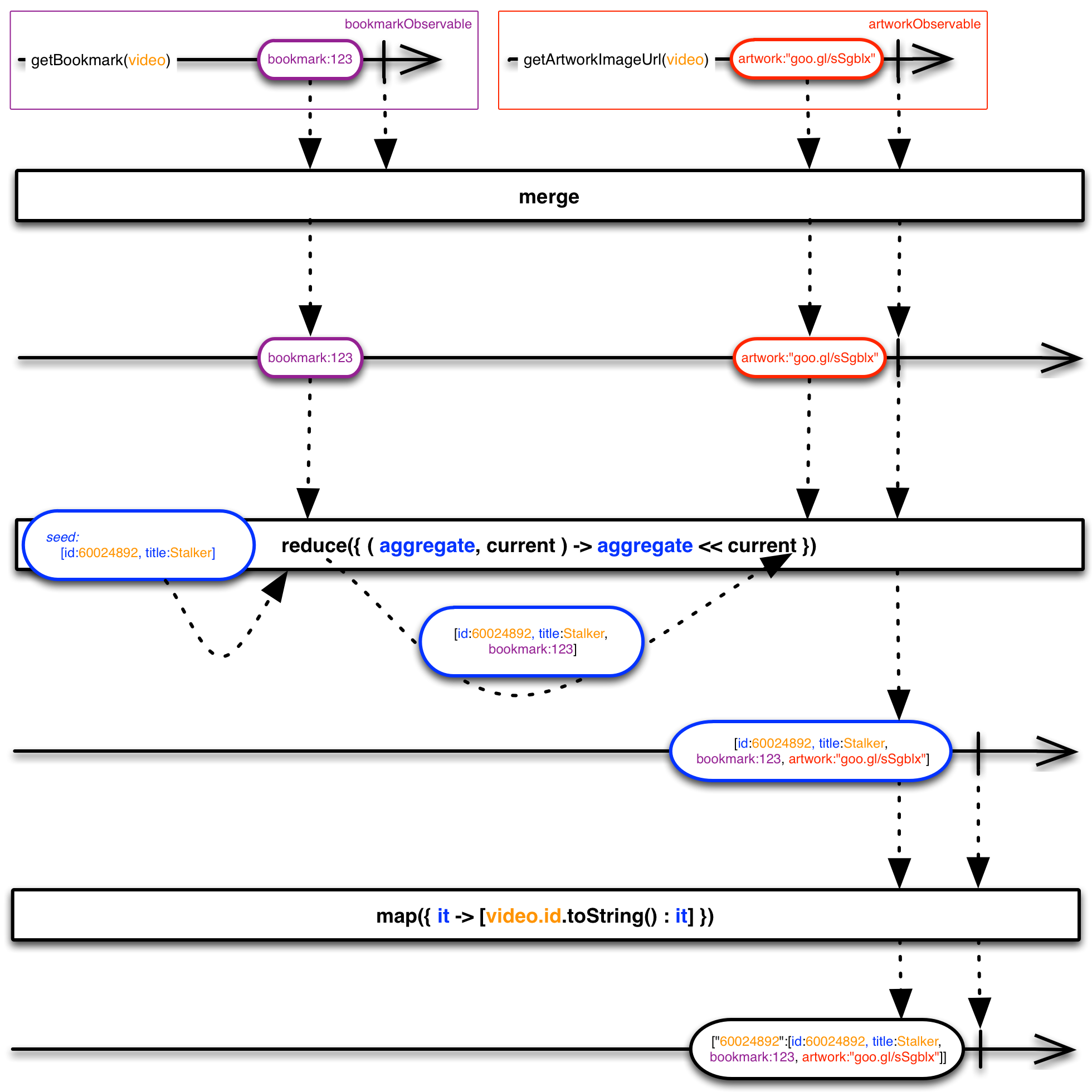第一个例子
你可以在这里找到JVM平台几种语言的例子 language adaptor:
下面的示例从一个字符串列表创建一个Observable,然后使用一个方法订阅这个Observable。
Java
public static void hello(String... names) {
Observable.from(names).subscribe(new Action1<String>() {
@Override
public void call(String s) {
System.out.println("Hello " + s + "!");
}
});
}
hello("Ben", "George");
Hello Ben!
Hello George!
Groovy
def hello(String[] names) {
Observable.from(names).subscribe { println "Hello ${it}!" }
}
hello("Ben", "George")
Hello Ben!
Hello George!
Clojure
(defn hello
[&rest]
(-> (Observable/from &rest)
(.subscribe #(println (str "Hello " % "!")))))
(hello ["Ben" "George"])
Hello Ben!
Hello George!
Scala
import rx.lang.scala.Observable
def hello(names: String*) {
Observable.from(names) subscribe { n =>
println(s"Hello $n!")
}
}
hello("Ben", "George")
Hello Ben!
Hello George!
如何使用RxJava
要使用RxJava,首先你需要创建Observable(它们发射数据序列),使用Observable操作符变换那些Observables,获取严格符合你要求的数据,然后观察并处理对这些数据序列(通过实现观察者或订阅者,然后订阅变换后的Observable)。
创建Observables
要创建Observable,你可以手动实现Observable的行为,也可以传递一个函数给create( ),还可以使用这些 创建操作符 将一个已有的数据结构转换为Observable。
已有的数据结构创建Observable
你可以使用just( ) 和from( ) 方法将对象,列表,对象属性转换为发射那些对象的Observable:
Observable<String> o = Observable.from("a", "b", "c");
def list = [5, 6, 7, 8]
Observable<Integer> o = Observable.from(list);
Observable<String> o = Observable.just("one object");
转换后的Observable每发射一项数据,会同步地调用任何订阅者的onNext()方法,最后会调用订阅者的onCompleted()方法。
使用create( )创建一个Observable
使用 create( ) 方法,你可以创建你自己的Observable,可以实现异步I/O,计算操作,甚至是无限的数据流。
同步的Observable示例
/**
* 这个例子展示了一个自定义的Observable,当有订阅时他会阻塞当前线程。
*/
def customObservableBlocking() {
return Observable.create { aSubscriber ->
50.times { i ->
if (!aSubscriber.unsubscribed) {
aSubscriber.onNext("value_${i}")
}
}
// after sending all values we complete the sequence
if (!aSubscriber.unsubscribed) {
aSubscriber.onCompleted()
}
}
}
// To see output:
customObservableBlocking().subscribe { println(it) }
异步的Observable示例
The following example uses Groovy to create an Observable that emits 75 strings.
下面的例子使用Groovy创建了一个发射75个字符串的Observable。
为了让它更清楚,例子很详细,使用静态类型和匿名内部类Func1:
/**
* This example shows a custom Observable that does not block
* when subscribed to as it spawns a separate thread.
*/
def customObservableNonBlocking() {
return Observable.create({ subscriber ->
Thread.start {
for (i in 0..<75) {
if (subscriber.unsubscribed) {
return
}
subscriber.onNext("value_${i}")
}
// after sending all values we complete the sequence
if (!subscriber.unsubscribed) {
subscriber.onCompleted()
}
}
} as Observable.OnSubscribe)
}
// To see output:
customObservableNonBlocking().subscribe { println(it) }
这是一个用Clojure写的例子,使用Future(而不是直接用线程),实现很简洁:
(defn customObservableNonBlocking []
"This example shows a custom Observable that does not block
when subscribed to as it spawns a separate thread.
returns Observable<String>"
(Observable/create
(fn [subscriber]
(let [f (future
(doseq [x (range 50)] (-> subscriber (.onNext (str "value_" x))))
; after sending all values we complete the sequence
(-> subscriber .onCompleted))
))
))
; To see output
(.subscribe (customObservableNonBlocking) #(println %))
这个例子从维基百科网站抓取文章,每抓取一篇会调用一次onNext:
(defn fetchWikipediaArticleAsynchronously [wikipediaArticleNames]
"Fetch a list of Wikipedia articles asynchronously.
return Observable<String> of HTML"
(Observable/create
(fn [subscriber]
(let [f (future
(doseq [articleName wikipediaArticleNames]
(-> subscriber (.onNext (http/get (str "http://en.wikipedia.org/wiki/" articleName)))))
; after sending response to onnext we complete the sequence
(-> subscriber .onCompleted))
))))
(-> (fetchWikipediaArticleAsynchronously ["Tiger" "Elephant"])
(.subscribe #(println "--- Article ---\n" (subs (:body %) 0 125) "...")))
回到Groovy,同样是从维基百科抓取文章,这儿使用闭包代替匿名内部类:
/*
* Fetch a list of Wikipedia articles asynchronously.
*/
def fetchWikipediaArticleAsynchronously(String... wikipediaArticleNames) {
return Observable.create { subscriber ->
Thread.start {
for (articleName in wikipediaArticleNames) {
if (subscriber.unsubscribed) {
return
}
subscriber.onNext(new URL("http://en.wikipedia.org/wiki/${articleName}").text)
}
if (!subscriber.unsubscribed) {
subscriber.onCompleted()
}
}
return subscriber
}
}
fetchWikipediaArticleAsynchronously("Tiger", "Elephant")
.subscribe { println "--- Article ---\n${it.substring(0, 125)}" }
结果:
--- Article ---
<!DOCTYPE html>
<html lang="en" dir="ltr" class="client-nojs">
<head>
<title>Tiger - Wikipedia, the free encyclopedia</title> ...
--- Article ---
<!DOCTYPE html>
<html lang="en" dir="ltr" class="client-nojs">
<head>
<title>Elephant - Wikipedia, the free encyclopedia</tit ...
Note that all of the above examples ignore error handling, for brevity. See below for examples that include error handling.
More information can be found on the [[Observable]] and [[Creating Observables|Creating-Observables]] pages.
注意:为了简洁,上面的所有例子都忽略了错误处理,查看下面包含错误处理的例子。
更多的信息可以在这里找到:Observable 和 Creating Observables。
使用变换操作
RxJava让你可以链式使用操作符用来转换和组合多个Observables。
The following example, in Groovy, uses a previously defined, asynchronous Observable that emits 75 items, skips over the first 10 of these (skip(10)), then takes the next 5 (take(5)), and transforms them (map(...)) before subscribing and printing the items:
下面是一个Groovy的例子,使用之前的定义,它会异步发射75个字符串,跳过最开始的10个((skip(10)),然后获取接下来的5个(take(5)),在订阅之前使用map()转换它们,然后打印结果字符串。
/**
* Asynchronously calls 'customObservableNonBlocking' and defines
* a chain of operators to apply to the callback sequence.
*/
def simpleComposition() {
customObservableNonBlocking().skip(10).take(5)
.map({ stringValue -> return stringValue + "_xform"})
.subscribe({ println "onNext => " + it})
}
输出结果
onNext => value_10_xform
onNext => value_11_xform
onNext => value_12_xform
onNext => value_13_xform
onNext => value_14_xform
这里有一个图例解释了转换过程:

这一个例子使用Clojure,使用了三个异步的Observable,其中一个依赖另一个,使用zip组合这三个发射的数据项为一个单个数据项,最后使用map()转换这个结果:
(defn getVideoForUser [userId videoId]
"Get video metadata for a given userId
- video metadata
- video bookmark position
- user data
return Observable<Map>"
(let [user-observable (-> (getUser userId)
(.map (fn [user] {:user-name (:name user) :language (:preferred-language user)})))
bookmark-observable (-> (getVideoBookmark userId videoId)
(.map (fn [bookmark] {:viewed-position (:position bookmark)})))
; getVideoMetadata requires :language from user-observable so nest inside map function
video-metadata-observable (-> user-observable
(.mapMany
; fetch metadata after a response from user-observable is received
(fn [user-map]
(getVideoMetadata videoId (:language user-map)))))]
; now combine 3 observables using zip
(-> (Observable/zip bookmark-observable video-metadata-observable user-observable
(fn [bookmark-map metadata-map user-map]
{:bookmark-map bookmark-map
:metadata-map metadata-map
:user-map user-map}))
; and transform into a single response object
(.map (fn [data]
{:video-id videoId
:video-metadata (:metadata-map data)
:user-id userId
:language (:language (:user-map data))
:bookmark (:viewed-position (:bookmark-map data))
})))))
输出是这样的:
{:video-id 78965,
:video-metadata {:video-id 78965, :title House of Cards: Episode 1,
:director David Fincher, :duration 3365},
:user-id 12345, :language es-us, :bookmark 0}
这里有一个图例解释了这个过程:

The following example, in Groovy, comes from Ben Christensen’s QCon presentation on the evolution of the Netflix API. It combines two Observables with the merge operator, then uses the reduce operator to construct a single item out of the resulting sequence, then transforms that item with map before emitting it:
下面的例子使用Groovy,来自这里 Ben Christensen’s QCon presentation on the evolution of the Netflix API,它使用merge操作结合两个Observables,使用reduce操作符从结果序列构建一个单独的结果数据项,然后在发射之前,使用map()变换那个结果。
public Observable getVideoSummary(APIVideo video) {
def seed = [id:video.id, title:video.getTitle()];
def bookmarkObservable = getBookmark(video);
def artworkObservable = getArtworkImageUrl(video);
return( Observable.merge(bookmarkObservable, artworkObservable)
.reduce(seed, { aggregate, current -> aggregate << current })
.map({ [(video.id.toString() : it] }))
}
这里也有一个图例解释reduce从多个Observable的结果构建一个单一结构的过程:

错误处理
这里是另一个版本的维基百科的例子,包含错误处理代码:
/*
* Fetch a list of Wikipedia articles asynchronously, with error handling.
*/
def fetchWikipediaArticleAsynchronouslyWithErrorHandling(String... wikipediaArticleNames) {
return Observable.create({ subscriber ->
Thread.start {
try {
for (articleName in wikipediaArticleNames) {
if (true == subscriber.isUnsubscribed()) {
return;
}
subscriber.onNext(new URL("http://en.wikipedia.org/wiki/"+articleName).getText());
}
if (false == subscriber.isUnsubscribed()) {
subscriber.onCompleted();
}
} catch(Throwable t) {
if (false == subscriber.isUnsubscribed()) {
subscriber.onError(t);
}
}
return (subscriber);
}
});
}
下面的例子使用Groovy,注意错误发生时现在是如何调用onError(Throwable t)的,下面的代码传递给subscribe()第二个方法用户处理onError通知:
fetchWikipediaArticleAsynchronouslyWithErrorHandling("Tiger", "NonExistentTitle", "Elephant")
.subscribe(
{ println "--- Article ---\n" + it.substring(0, 125) },
{ println "--- Error ---\n" + it.getMessage() })
查看 错误处理操作符 这一页了解更多RxJava中的错误处理技术,包括使用 onErrorResumeNext()和onErrorReturn()等方法,它们让你可以从错误中恢复。
这里是一个Groovy的例子:
myModifiedObservable = myObservable.onErrorResumeNext({ t ->
Throwable myThrowable = myCustomizedThrowableCreator(t);
return (Observable.error(myThrowable));
});